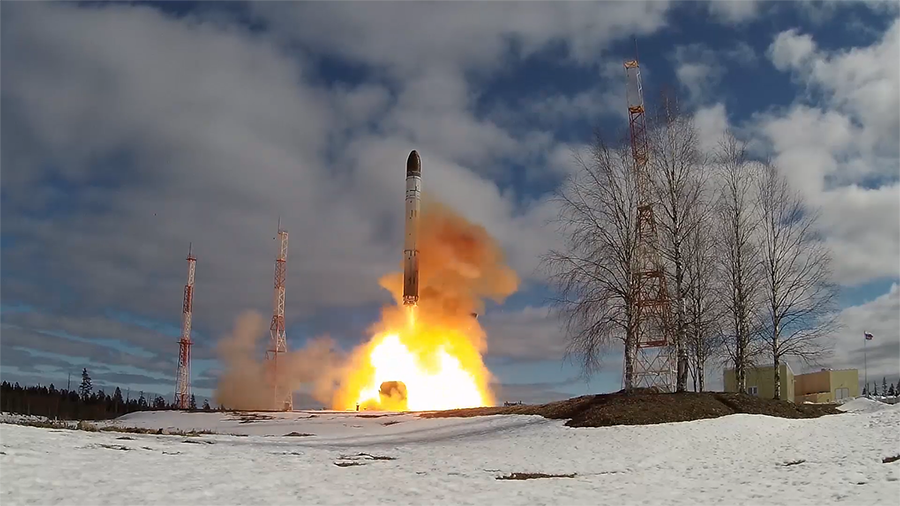Global Nuclear Freeze Could Avert New Arms Race
April 2023
By Daryl G. Kimball
After more than a decade of deteriorating relations and dithering on disarmament, the three largest nuclear powers—Russia, the United States, and China—are on the verge of an unconstrained era of dangerous nuclear competition.
 Because there are no winners in a nuclear war or a costly nuclear arms race, leaders in Washington, the leading non-nuclear-weapon states, and concerned people everywhere need to press these states, as well as France and the United Kingdom, to exercise restraint and engage in disarmament diplomacy.
Because there are no winners in a nuclear war or a costly nuclear arms race, leaders in Washington, the leading non-nuclear-weapon states, and concerned people everywhere need to press these states, as well as France and the United Kingdom, to exercise restraint and engage in disarmament diplomacy.
The problems go back at least to 2013, when Russia rebuffed a U.S. proposal to negotiate a further cut of their strategic arsenals of one-third below the levels of the 2010 New Strategic Arms Reduction Treaty (New START), from 1,550 to 1,000 deployed warheads. Since then, the two sides have barely discussed new arms control ideas as they aggressively pursued rival nuclear weapons modernization programs. Today, each possesses some 4,000 warheads of all types.
On Feb. 21, just two years after agreeing to extend New START by five years, Russian President Vladimir Putin announced that Russia is suspending implementation of the pact, although for now it will observe its limits. He claims he will not engage in arms control talks until the White House softens support for the defense of Ukraine against Russia’s brutal war of aggression.
At the same time, China has embarked on a major buildup of its relatively small but still deadly nuclear arsenal. According to the Pentagon, China has more than 400 deployed warheads, 300 of which are on land- and sea-based strategic missiles, and possibly could deploy about 1,500 warheads by 2035.
Putin’s decision to suspend New START is not the end of the treaty, but it makes it likely that, after New START expires in 2026, there will be no agreement limiting U.S. and Russian arsenals for the first time since 1972. Without such constraints, each side could quickly double its strategic arsenal to 3,000 or more deployed warheads by uploading additional warheads on missiles. If Russia and the United States break out of New START limits, China undoubtedly would accelerate its own nuclear buildup to ensure its nuclear retaliatory capabilities.
Key figures in the U.S. nuclear weapons establishment, including former Pentagon war planners, defense contractor-funded pundits, and Republicans from districts hosting nuclear facilities, argue that the United States should respond by increasing the size of its nuclear arsenal and developing new nuclear weapons for the first time in decades.
What is to be done? To start, Russia and the United States need to reengage on nuclear risk reduction talks and agree to continue observing the central limits of New START until a new nuclear arms control framework is concluded. Under Article VI of the nuclear Nonproliferation Treaty, they are obligated to “pursue negotiations in good faith on effective measures relating to cessation of the nuclear arms race at an early date and to
nuclear disarmament.”
As importantly, leaders in Washington and other capitals should urge China, France, and the UK to agree to freeze the size of their arsenals as long as Russia and the United States meet their disarmament responsibilities. A global freeze on the expansion of nuclear arsenals would not eliminate the threat of nuclear war, but it would increase the chance that China finally might engage in arms control and improve conditions for progress on nuclear risk reduction and disarmament.
U.S. policymakers should not increase the already enormous U.S. arsenal or press for new weapons, such as a nuclear-armed, sea-launched cruise missile out of fear of facing two near-peer nuclear rivals.
As U.S. Defense Secretary Lloyd Austin said on Dec. 9, “Nuclear deterrence isn’t just a numbers game. In fact, that sort of thinking can spur a dangerous arms race.” The Pentagon also says a new sea-launched cruise missile with a new warhead would have “zero value” and would not be completed until 2035 or later.
Any decision to increase the number of deployed U.S. strategic nuclear weapons above New START levels or to build new varieties of nuclear weapons would not only be costly but counterproductive. It would make it more likely that China would decide to deploy more nuclear weapons on an even wider array of delivery systems over the coming decade.
The U.S. nuclear arsenal far exceeds what is necessary to hold sufficient assets of an adversary at risk of nuclear obliteration and thus deter a nuclear attack. Even if Russia and China increase their long-range nuclear arsenals, that move would have little to no effect on the U.S. “assured second-strike capabilities,” which include nearly 1,000 nuclear warheads on strategic submarines.
Nuclear weapons pose global dangers. Their elimination requires a global enterprise involving renewed, robust leadership, dialogue, and action by all nations. A unified push for further Russian-U.S. arms cuts combined with a global nuclear weapons freeze could create the conditions for serious and overdue multilateral action on disarmament and a safer world for all.
